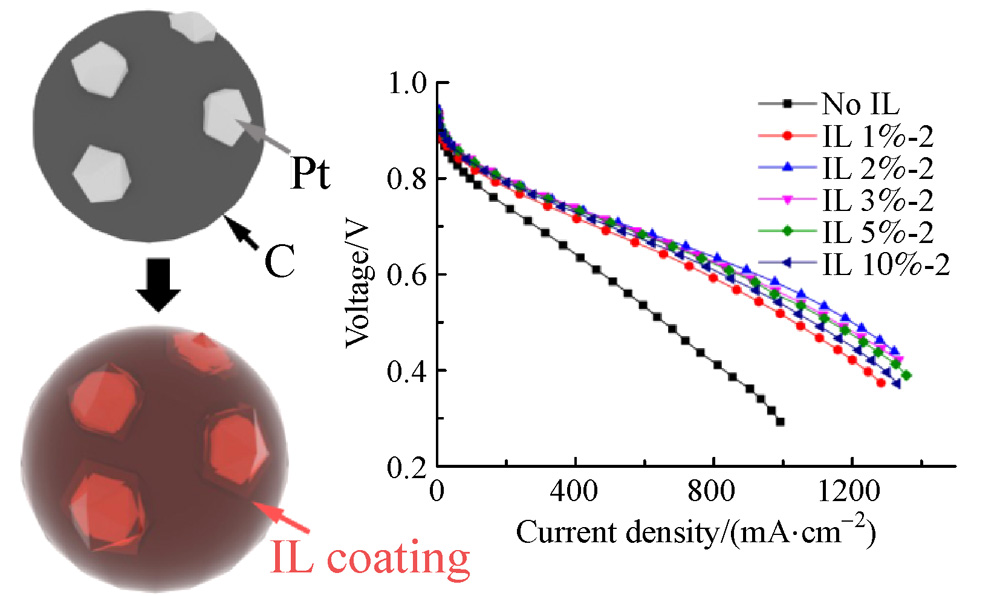Figures 3(a) and 3(b) compare the polarization and power density curves measured for MEAs fabricated from cathodes using Pt/C and Pt/C@IL catalysts. The MEAs with IL-modified cathodic catalysts exhibit much better power performances than that of the unmodified catalyst within the entire current density region studied and the improvement varies depending on the initial IL concentration. The highest power performance was obtained with 2% IL-2, increasing to 0.605 W·cm
−2 from 0.337 W·cm
−2 of the unmodified Pt/C, about 1.8 times higher. The improvement can be explained by two reasons as indicated by Snyder et al. [
3,
4] and Zhang et al. [
5,
6,
16]: (i) for the catalyst nanoparticles without the IL, the pores on the catalyst surface can trap stagnant gas, forming inactive sites thus reduce the catalytic activities; (ii) the higher solubility of oxygen in IL [MTBD][NTf
2] increases the oxygen concentration around the catalyst surface, and the thin IL layer facilitates the desorption of nonreactive species and reactants, as well as covers the defect sites on catalyst surface from oxidation, thus increasing the available sites for oxygen adsorption, playing an antioxidant role in fuel cell operation and improving the ORR kinetics. This mainly contributed to the low current density region. At the high current density region, due to the superhydrophobic property of IL [MTBD][NTf
2], the water produced in the reaction is expelled preventing them assembling on catalyst surface and providing more active sites, increasing the ORR frequency and minimizing the effect of mass transport. Thus, by IL surface modification, active sites are activated and ORR is accelerated, finally leading to boosted power performance in fuel cell operation. But, a further increase of the IL initial concentration above 2% results in a decrease of the power performance, declining to 0.550 W·cm
−2 at 10% IL-2, which can be attributed to the large molecular cluster size of the IL solution at a higher concentration which further affects their coating behavior on the catalyst surface. A thicker IL layer is finally obtained on catalyst surface, which is not prone to oxygen diffusion and will partially blocking the pores between catalyst nanoparticles within the catalyst layer finally leads to a decrease of the electrode power performance in fuel cell operation [
17–
20]. This is different from conclusions that the site blocking effect from ILs can be ignored by half cell electrochemical measurement due to a large amount of water produced in fuel cell operation; and it can also be found that the optimal amount of the IL for surface modification in fuel cell electrodes is much lower compared to that reported by half cell electrochemical measurement [
5,
6,
16], further confirming the big difference between both activity evaluation methods [
9,
10]. EIS measurement was conducted to provide more insight into the electrode properties and the spectrum measured at 0.6 V is shown in Fig. 3(c). The intersection of the spectra on the real impedance-axis at the high frequency regime is attributed to uncompensated ohmic resistance, which is primarily from the ionic resistance of the membrane and interfacial contact resistance in MEAs. All MEAs show nearly the same value here due to the same membrane and test conditions used. With EIS, there are two semicircles; the first impedance semicircle is mainly contributed by the charge transfer resistance and the second one by mass transfer resistance. The diameter of the first impedance semicircle is reduced after the catalyst is modified with the IL, indicating the improvement of the charge transfer performance; that is, the catalytic activity of the IL modified Pt/C becomes higher, as also confirmed by the polarization curves. With the increase of the IL amount, the second semicircle also keeps increasing, demonstrating an increased mass transfer resistance due to the partially blocking of the pores within the electrodes.









